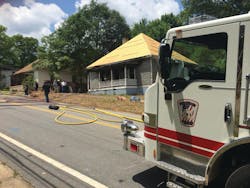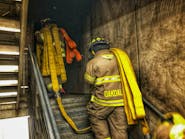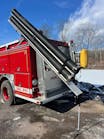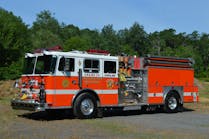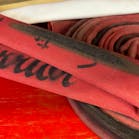Fire Research: Does Your Toolbox Have All the Proper Tools
In a recent magazine editorial my friend Tim Sendelbach made one of the most reasonable statements that I have seen in a long time. He was writing about the results of the research projects which have been conducted by the National Institute of Standards and Training (NIST). In particular he was writing about the burn tests which were held recently in Spartanburg, S.C.
I thought that his words were outstanding in that he covered both sides of a particular argument on fire attack methodology. Tim stated that he was still not convinced one way or the other; but that he intended to keep an open mind and continue to study the research results as they continue to emerge from the NIST research efforts. The dichotomy to which he alluded involved the "go in and attack the fire at its seat" school of thought and the "shoot some water through the window to cool the fire" approach to firefighting attack procedures.
Let me state for the record that this can be a hotly contested matter in some parts of the world. The inside-attack advocates have taken to calling the "shoot water through the window" folks sissies. The outside-oriented folks have taken to calling the inside folks suicidal in their approach to operations. My friends, the jury has not yet returned their verdict in this important matter. Like Tim, I want to state that I am maintaining an open mind on all of these firefighting-related matters. But I want to go one step further, I want to state that I fervently believe that there is a place for both of these attack approaches.
For many years my friends, I was that voice in the wilderness crying out for new research initiatives to make things safer for those of us who respond to fires and other emergencies on a daily basis. People fought me. Many suggested that we already knew all we needed to know in the firefighting business. I suggested that we needed to assess the ways in which fires burned, the changes in the impact of construction and furniture, as well as a review of the ways in which our tasks to see if they were still appropriate for today’s type of fires.
You can imagine the joy in my heart when the various research programs were scheduled and then conducted. Given my busy schedule I was not able to schedule my attendance at these important sessions. However, as a trained academic researcher, I have been able to follow the findings thanks to the fine reports which have been produced by the folks at NIST.
Another professional buddy, Daniel Madrzykowski, heads up the fire research program for the fire service at NIST. He has labored valiantly over the year to keep the fire service in the forefront of operational improvements in an effort to keep our people safe and recommend operational changes based upon their research. Thanks to his efforts we now know how differently fire burns.
Back when I was a rookie, the thought was that a fire would reach the flashover stage within 10 minutes. Because of this many of our fire department pre-planning policies and procedures revolved around getting your fire attack in place to put water on the fire within the 10-minute window. I know this because this is the standard I have used in my consulting practice.
Thanks to the research at NIST we now know that a fire can flash in a lot less time than the old 10-minute mark. This puts the pressure on us to conduct our firefighting efforts in a safer manner. Hence we have heard the call to shoot water in to cool the fire prior to our entry into the involved structure. I think that this makes sense.
I want you to know that back in my days with the Newark Fire Department we prided ourselves on our interior firefighting expertise. I believe that we had some of the toughest firefighters on the face of the earth. However, one of my favorite tactical approaches to firefighting involved my personal choice to use the deck gun on our pumper to hit the heart of the fire.
This operation required dropping one guy at the hydrant to hookup. The pumper would then stretch our feed lines from the hydrant to the front of the burning building. I would then climb up on the pumper in order to turn the deck gun toward the burning structure in order to hit the fire. The driver would then send me the tank water and I would begin knocking down the fire.
As this was going on, the fourth man would be stretching the 1-1/2-inch attack line to the front door. Once the driver had the feed lines attached to the pumper and was receiving hydrant water; and I had knocked the heavy fire down with the deck gun, the fourth guy and I would don our SCBA and move in on the fire with the handline. One night I used this method at the scene of a blazing commercial laundry. We stretched in and when we got to the front of the building I called a working fire and requested a second alarm.
Our attack with the deck gun was so successful that by the time our battalion chief (BC) arrived, he saw us heading in with the handline to finish off the fire. When my crew and I came out, the BC called me aside and asked why I had called the additional alarm. I explained what I found upon arrival. He saw the wisdom of my operation and he and the deputy both commended the efforts of our engine company.
There have also been a number of improvements to the suggested ventilation practices which we are supposed to use at structural fires. People have suggested that roof top ventilation is no longer necessary; that it can be replaced by the use of positive-pressure ventilation devices. Personally I have seen both successes and failures in the use of positive pressure ventilation. I am keeping an open mind on this. I will continue to study the ventilation results as it comes out from the NIST programs. I will continue to work as a member of my volunteer fire department training, sharing, and learning the new ways of doing business.
Herein lays the reason for this particular commentary visit with you. There is no single best way to do each of our operations which can be used every time in every situation. There are many ways to do each thing we do. I fervently believe that each of us needs to create a toolbox of emergency response skills. This is in addition to your full toolbox of leadership and management skills. We need to be able to apply several different skills on an as-needed basis.
Each of our tasks must be applied in a manner which is appropriate for the situation we face at a given emergency. This is an area wherein my friend Dr. Rich Gassaway excels. He teaches that Situational Awareness Matters. He travels the nation teaching an ever-growing array of audiences that we must always be aware of what is going one around us. How can you possibly use the correct tool from your toolbox if you are not paying attention to the incident as it unfolds in front of your eyes?
Let me close this visit with you by strongly recommending that there is no single, best way to do any single task. I want you to review the NIST research, form up your opinions, learn the many ways to do your job, and the neatly place these tools in your emergency service tool box. Have them ready to grab when you arrive on location, discover what you have, and perform your size-up.
Please create that toolbox. Please create the tools and talents necessary to fill that box with all that you need. Use it frequently and use it wisely, Remember; you should not ever expect to screw in a Phillips head screw with a monkey wrench. Neither should you use a sledgehammer to tap in a tack.
Oh, and by the way, you should never make fun of how the other person chooses to do their job, You can hold discussions. You can have open and honest interactions. You can have negotiations. You can even make friendly suggestions, but remember; no one among us is perfect. Reflecting back on decades of mistakes I am here to tell you that I have no standing to criticize.
Thanks to my friend Tim Sendelbach for lighting the fire under me to create this visit with you.
HARRY R. CARTER, Ph.D., CFO, MIFireE, a Firehouse.com Contributing Editor, is a municipal fire protection consultant based in Adelphia, NJ. Dr. Carter retired from the Newark, NJ, Fire Department and is a past chief and active life member of the Adelphia Fire Company. Follow Harry on his "A View From my Front Porch" blog. You can reach Harry by e-mail at [email protected].
